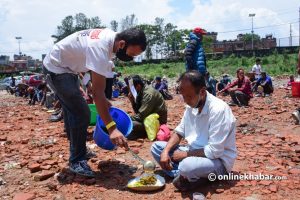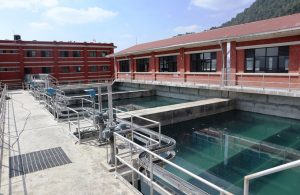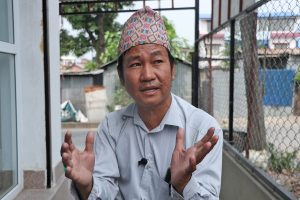
At 6 am on a usual Saturday morning, a large number of people gather around an organic green tea shop at Dhankute Road, Dharan, creating traffic congestion. Harka Sampang, the mayor of the Dharan sub-metropolitan city dressed in a tracksuit covered with dirt and dust, is seen with a microphone requesting them to clear the way for smooth traffic movement. These people are the volunteers who came to help the mayor by providing free labour for a cause, for clean drinking water in Dharan.
With his command, vehicles loaded with food, water, and pipes leave for the site. At 8, Sampang leaves for the site and other vehicles like buses and motorcycles follow him. It looks like a kind of procession.
They stop at the Baghuwa stream and get divided into three groups. One group starts tying a rope to the pipe, and two people carry the pipe and climb uphill in the forest. After leaving the pipe there, they go down and climb up again carrying the pipe.
Former British Gurkha Pasang Sherpa (70) says he did not even imagine that hundreds of people would come to build a system for drinking water in Dharan to bring water to Dharan in his lifetime. But now he himself is in that crowd, carrying pipes in the hot weather.
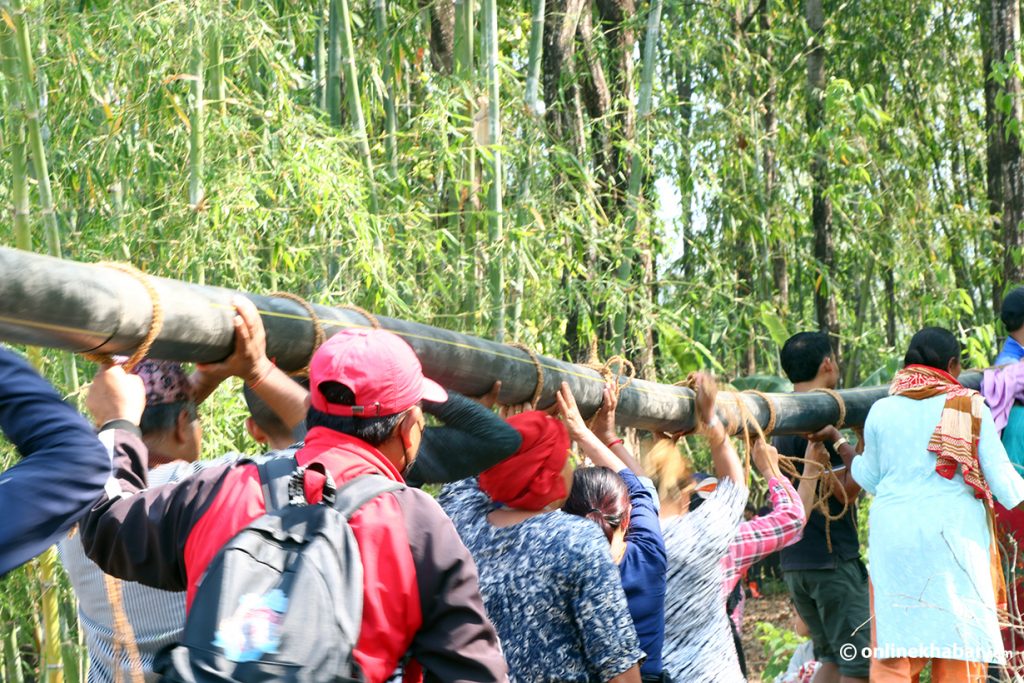
Meanwhile, meals are being prepared on the banks of the stream for the workers. At around 12, volunteers have lunch. Then, some return home, and some go uphill to the forest to carry the pipes again.
By 6 in the evening, those who are engaged in volunteering for drinking water in Dharan return home. Mayor Sampang returns at last. “He is the first to go and the last to return,” says Ashok Sharma, a member of his secretariat.
After being elected last year, Harka Sampang has made drinking water in Dharan his number one priority. And, he is working on it by mobilising the people themselves to set an example of how democracy works.
Weekly volunteering drive
Sampang, who was elected as the mayor of Dharan in 2022, has run a volunteering campaign every Saturday for drinking water in Dharan. He calls Saturdays Dharan’s volunteers’ day. In his call, people volunteer, not only as individuals but also at the institutional level. Gym clubs, cooperatives, banks, and Gorkha recruitment centres in Dharan actively contribute to the campaign.
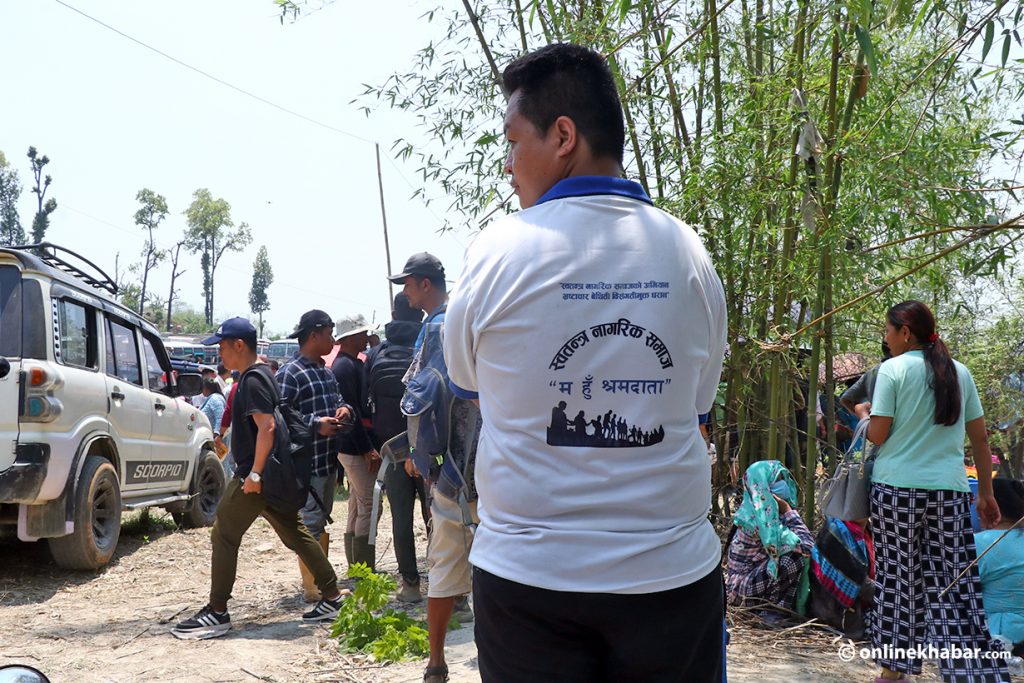
Sanjita Rai (38), wearing a t-shirt showing the logo of the Bagarkot businessperson’s committee, says she had previously volunteered twice. “Right now, we have joined the campaign as a decision was made by our business committee to work voluntarily,” she says.
Dharan’s drinking water dearth
Nestled at the foot of the Mahabharata mountain range, Dharan has everything except water. Some 120 years ago, when Chandra Shamsher established the city, the situation was opposite to what it is now. Some 15 years after that, the water from the Turke stream reached Gomukhe Dhara. The springs around the Bijayapur hills would also supply drinking water in Dharan.
But, now, there is not enough water in the Turke. There are only pipes that remind the locals that once there was water, which used to reach the city.
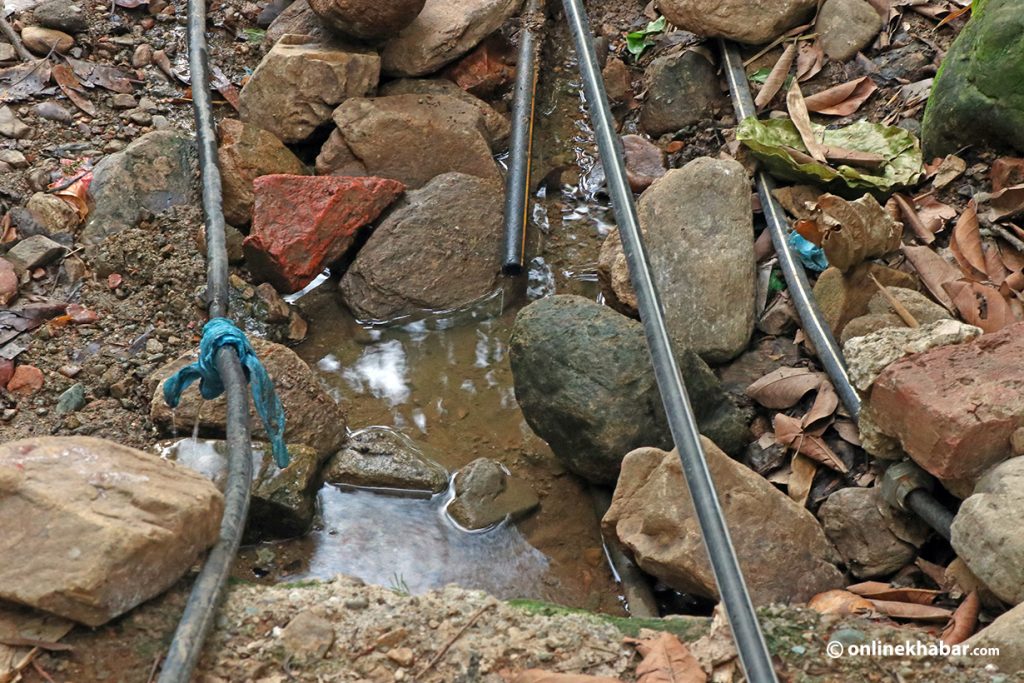
After the development of the eastern hill as a commercial centre, people settled at the foot of the hills where the water sources were located. Houses were built in places where there were water sources.
“After the British government opened an office to recruit Gurkha soldiers in Dharan, the population here increased, the hustle and bustle also increased,” says Rajendra Sharma, a former associate professor of Mahendra Multiple Campus, “Then, gradually, drinking water in Dharan became a big problem.”
To solve the problem, King Birendra Shah ordered the removal of the settlements around the Sardu reservoir. Those families were moved to Shanischare in Morang. In the late 1980s, Nepal Water Supply Corporation placed pipes from the Sardu watershed area and supplied water to the public taps in Dharan.
But even this could not satisfy the thirst of the growing population. A drinking water project started in the early 2010s with the help of the Asian Development Bank (ADB) to bring water from deep tube wells buried in the Charkose forest.
But even this could not help the shortage of drinking water in Dharan. “If the ADB project had provided water as per the plan, we would not have been suffering from a water crisis,” says Ganesh Paudel, a local businessperson.
According to Raju Pokharel, the executive director of the Dharan Water Supply Management Board, the board currently distributes around 20 million litres of water to the residents of Dharan every day, collected from deep tube wells and other sources. “However, Dharan needs 30 million litres of water daily,” he says.
Due to a lack of supply as per the demand, people stand in line carrying water vessels for their turn to fill them on the scheduled water supply days. Surya Rai says, “I go to the Water Supply Board’s office for taking a bath and go to relatives for washing my clothes.”

The rise of Harka Sampang
As drinking water in Dharan is the main problem at hand, political parties have been using this as their election agenda. In the hope of quenching the thirst, the people of Dharan sometimes elected the UML and sometimes the Nepali Congress leaders as the mayor. But their suffering was not addressed. So, this time, they selected the independent candidate Sampang as their mayor.
Sampang, who has been active in social campaigns in Dharan for a decade, wooed locals after protesting about corruption in the water supply project. Sampang started a water campaign as soon as he returned to Nepal from his six-year stay in Iraq and Afghanistan.
Sampang says people there do not suffer from drinking water shortages in the deserts like Iraq and Afghanistan, but here, locals always have to bear the brunt. “After that, I started a campaign to find out what was wrong with drinking water in Dharan.”
After being elected the mayor, he swore that he would quench the thirst of Dharan no matter what. Right now, Sampang is working hard to fulfil that promise. Every time he goes to the forest to work for water, he wears a tracksuit that later gets covered with dust and mud.
Budding hopes
Harka Sampang has run a volunteer labour campaign without even taking a decision from the sub-metropolitan city. Even though he is the mayor, he is also criticised for not making a decision from the municipality and for starting the placement of pipes for drinking water in Dharan without following the process of environmental impact and feasibility studies.
But in response to criticism, he asks, “Do you want water or paper?”
However, he has brought the water from Pakuwa, Sardu, Nishane and Balukhola streams to Dharan with the help of volunteers. These rivers run out of water in the dry season and cannot fulfil the long-term need of the locals.
Yet locals are hopeful. With the same hope, volunteer Pasang Sherpa says, “Harka Sampang did what the party leaders could not do for so many years.”
Hundreds of people like him believe the problem of drinking water in Dharan will be solved with the strength of volunteerism and work every Saturday for free.
Businesspersons have donated according to their capacity for the water campaign. Locals living abroad have also sent money. Every Saturday morning, people come to the organic green tea shop at Dhankuta Road to work and meet the mayor.
Pavitra Rai (65) of Dharan-16 arrives there on Sunday morning. Recently, she also donated Rs 100,000 for drinking water in Dharan. “I can’t volunteer to work. So, I decided to give it to those who work,” she was heard saying while handing over the money, “If you can work, you can volunteer and if you can’t, you have to help in some way.”

According to Dutt Kumar Limbu, who is managing the donations coming in this way, around Rs 90.5 million has been collected in cash and in kind. Rs 20 million have already been spent in efforts to bring water from the Kokah stream, which is the current site of work. It is estimated that another Rs 20 million will be required for the completion of the project.
Funds are used to purchase supplies for the equipment and other supplies as well as for food and water for the volunteers committed to solving the problem of drinking water in Dharan. According to Ashok Rai, who is in the secretariat of Sampang, about 40 people have been employed for the project where each employee is paid a daily wage of Rs 1,100. They help in the technical aspect of the project.
Mayor Sampang, desperate to solve the problem, says, “So many people come to donate, which has given financial support to the campaign as well as opened the obstacles on the path for drinking water in Dharan.”
This story was translated from the original Nepali version and edited for clarity and length.








